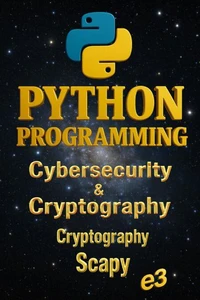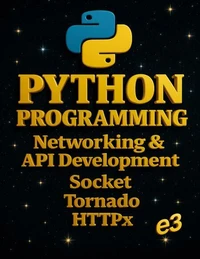Python Programming: General-Purpose Libraries; NumPy,Pandas,Matplotlib,Seaborn,Requests,os & sys. Python, #2
Par :Formats :
Disponible dans votre compte client Decitre ou Furet du Nord dès validation de votre commande. Le format ePub est :
- Compatible avec une lecture sur My Vivlio (smartphone, tablette, ordinateur)
- Compatible avec une lecture sur liseuses Vivlio
- Pour les liseuses autres que Vivlio, vous devez utiliser le logiciel Adobe Digital Edition. Non compatible avec la lecture sur les liseuses Kindle, Remarkable et Sony
 , qui est-ce ?
, qui est-ce ?Notre partenaire de plateforme de lecture numérique où vous retrouverez l'ensemble de vos ebooks gratuitement
Pour en savoir plus sur nos ebooks, consultez notre aide en ligne ici
- FormatePub
- ISBN8230635468
- EAN9798230635468
- Date de parution12/03/2025
- Protection num.pas de protection
- Infos supplémentairesepub
- ÉditeurIndependently Published
Résumé
Python has solidified its place as one of the most versatile and powerful programming languages in the world, thanks to its simplicity, readability, and extensive support for various fields such as data science, web development, machine learning, and automation. For anyone embarking on a journey into the world of programming, Python offers a gateway that is both accessible and highly functional. This book, Python Programming: General-Purpose Libraries; NumPy, Pandas, Matplotlib, Seaborn, Requests, os & sys, is designed to be a comprehensive guide to mastering Python's essential general-purpose libraries.
These libraries are crucial tools for anyone looking to perform data analysis, visualization, or automation. By the end of this book, you will have gained the foundational skills required to leverage these libraries to their full potential in real-world projects. In the first part of the book, we will delve into NumPy, the cornerstone of numerical computing in Python. With its array objects and mathematical functions, NumPy allows us to efficiently manipulate large datasets and perform complex mathematical operations.
We will explore NumPy's capabilities and how it serves as the backbone for other scientific libraries. Next, we will tackle Pandas, an indispensable library for data manipulation and analysis. Pandas provides powerful tools for working with structured data, including Series and DataFrames, which allow you to clean, filter, and analyze data in ways that are both intuitive and efficient. The goal is to provide you with a deep understanding of how to handle data in various formats such as CSV, Excel, and SQL databases.
Matplotlib and Seaborn will introduce you to the art of data visualization. While Matplotlib allows you to create a wide array of static, animated, and interactive visualizations, Seaborn enhances Matplotlib's capabilities with a simpler syntax and aesthetically pleasing statistical graphics. By the end of this section, you'll have a solid grasp of how to represent complex data visually and communicate insights through charts, graphs, and plots.
Requests is the library that simplifies working with HTTP requests in Python, allowing you to interact with web APIs, download files, and retrieve data from the web. Understanding how to use this library effectively is key to working with external data sources, making it a vital tool in web scraping, web services, and automation projects. Finally, we will cover os and sys, two libraries that allow you to interact with the underlying operating system and perform tasks like file management, process control, and environment variable handling.
These libraries are essential for building Python scripts that automate and streamline tasks on your computer. Throughout this book, we will balance theory with practical, hands-on examples. Each chapter contains exercises that reinforce the concepts introduced, helping you build a strong foundation and enabling you to apply what you've learned to real-world problems. Whether you are a beginner eager to explore Python or an experienced programmer looking to deepen your understanding of these libraries, this book will serve as an invaluable resource.
Welcome to the exciting world of Python programming. Let's begin this journey together and unlock the potential of Python's general-purpose libraries! - The Author
These libraries are crucial tools for anyone looking to perform data analysis, visualization, or automation. By the end of this book, you will have gained the foundational skills required to leverage these libraries to their full potential in real-world projects. In the first part of the book, we will delve into NumPy, the cornerstone of numerical computing in Python. With its array objects and mathematical functions, NumPy allows us to efficiently manipulate large datasets and perform complex mathematical operations.
We will explore NumPy's capabilities and how it serves as the backbone for other scientific libraries. Next, we will tackle Pandas, an indispensable library for data manipulation and analysis. Pandas provides powerful tools for working with structured data, including Series and DataFrames, which allow you to clean, filter, and analyze data in ways that are both intuitive and efficient. The goal is to provide you with a deep understanding of how to handle data in various formats such as CSV, Excel, and SQL databases.
Matplotlib and Seaborn will introduce you to the art of data visualization. While Matplotlib allows you to create a wide array of static, animated, and interactive visualizations, Seaborn enhances Matplotlib's capabilities with a simpler syntax and aesthetically pleasing statistical graphics. By the end of this section, you'll have a solid grasp of how to represent complex data visually and communicate insights through charts, graphs, and plots.
Requests is the library that simplifies working with HTTP requests in Python, allowing you to interact with web APIs, download files, and retrieve data from the web. Understanding how to use this library effectively is key to working with external data sources, making it a vital tool in web scraping, web services, and automation projects. Finally, we will cover os and sys, two libraries that allow you to interact with the underlying operating system and perform tasks like file management, process control, and environment variable handling.
These libraries are essential for building Python scripts that automate and streamline tasks on your computer. Throughout this book, we will balance theory with practical, hands-on examples. Each chapter contains exercises that reinforce the concepts introduced, helping you build a strong foundation and enabling you to apply what you've learned to real-world problems. Whether you are a beginner eager to explore Python or an experienced programmer looking to deepen your understanding of these libraries, this book will serve as an invaluable resource.
Welcome to the exciting world of Python programming. Let's begin this journey together and unlock the potential of Python's general-purpose libraries! - The Author
Python has solidified its place as one of the most versatile and powerful programming languages in the world, thanks to its simplicity, readability, and extensive support for various fields such as data science, web development, machine learning, and automation. For anyone embarking on a journey into the world of programming, Python offers a gateway that is both accessible and highly functional. This book, Python Programming: General-Purpose Libraries; NumPy, Pandas, Matplotlib, Seaborn, Requests, os & sys, is designed to be a comprehensive guide to mastering Python's essential general-purpose libraries.
These libraries are crucial tools for anyone looking to perform data analysis, visualization, or automation. By the end of this book, you will have gained the foundational skills required to leverage these libraries to their full potential in real-world projects. In the first part of the book, we will delve into NumPy, the cornerstone of numerical computing in Python. With its array objects and mathematical functions, NumPy allows us to efficiently manipulate large datasets and perform complex mathematical operations.
We will explore NumPy's capabilities and how it serves as the backbone for other scientific libraries. Next, we will tackle Pandas, an indispensable library for data manipulation and analysis. Pandas provides powerful tools for working with structured data, including Series and DataFrames, which allow you to clean, filter, and analyze data in ways that are both intuitive and efficient. The goal is to provide you with a deep understanding of how to handle data in various formats such as CSV, Excel, and SQL databases.
Matplotlib and Seaborn will introduce you to the art of data visualization. While Matplotlib allows you to create a wide array of static, animated, and interactive visualizations, Seaborn enhances Matplotlib's capabilities with a simpler syntax and aesthetically pleasing statistical graphics. By the end of this section, you'll have a solid grasp of how to represent complex data visually and communicate insights through charts, graphs, and plots.
Requests is the library that simplifies working with HTTP requests in Python, allowing you to interact with web APIs, download files, and retrieve data from the web. Understanding how to use this library effectively is key to working with external data sources, making it a vital tool in web scraping, web services, and automation projects. Finally, we will cover os and sys, two libraries that allow you to interact with the underlying operating system and perform tasks like file management, process control, and environment variable handling.
These libraries are essential for building Python scripts that automate and streamline tasks on your computer. Throughout this book, we will balance theory with practical, hands-on examples. Each chapter contains exercises that reinforce the concepts introduced, helping you build a strong foundation and enabling you to apply what you've learned to real-world problems. Whether you are a beginner eager to explore Python or an experienced programmer looking to deepen your understanding of these libraries, this book will serve as an invaluable resource.
Welcome to the exciting world of Python programming. Let's begin this journey together and unlock the potential of Python's general-purpose libraries! - The Author
These libraries are crucial tools for anyone looking to perform data analysis, visualization, or automation. By the end of this book, you will have gained the foundational skills required to leverage these libraries to their full potential in real-world projects. In the first part of the book, we will delve into NumPy, the cornerstone of numerical computing in Python. With its array objects and mathematical functions, NumPy allows us to efficiently manipulate large datasets and perform complex mathematical operations.
We will explore NumPy's capabilities and how it serves as the backbone for other scientific libraries. Next, we will tackle Pandas, an indispensable library for data manipulation and analysis. Pandas provides powerful tools for working with structured data, including Series and DataFrames, which allow you to clean, filter, and analyze data in ways that are both intuitive and efficient. The goal is to provide you with a deep understanding of how to handle data in various formats such as CSV, Excel, and SQL databases.
Matplotlib and Seaborn will introduce you to the art of data visualization. While Matplotlib allows you to create a wide array of static, animated, and interactive visualizations, Seaborn enhances Matplotlib's capabilities with a simpler syntax and aesthetically pleasing statistical graphics. By the end of this section, you'll have a solid grasp of how to represent complex data visually and communicate insights through charts, graphs, and plots.
Requests is the library that simplifies working with HTTP requests in Python, allowing you to interact with web APIs, download files, and retrieve data from the web. Understanding how to use this library effectively is key to working with external data sources, making it a vital tool in web scraping, web services, and automation projects. Finally, we will cover os and sys, two libraries that allow you to interact with the underlying operating system and perform tasks like file management, process control, and environment variable handling.
These libraries are essential for building Python scripts that automate and streamline tasks on your computer. Throughout this book, we will balance theory with practical, hands-on examples. Each chapter contains exercises that reinforce the concepts introduced, helping you build a strong foundation and enabling you to apply what you've learned to real-world problems. Whether you are a beginner eager to explore Python or an experienced programmer looking to deepen your understanding of these libraries, this book will serve as an invaluable resource.
Welcome to the exciting world of Python programming. Let's begin this journey together and unlock the potential of Python's general-purpose libraries! - The Author





















